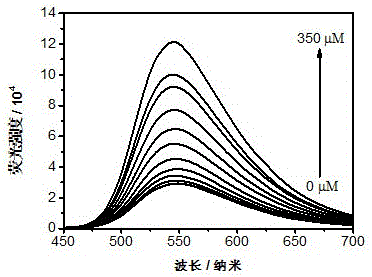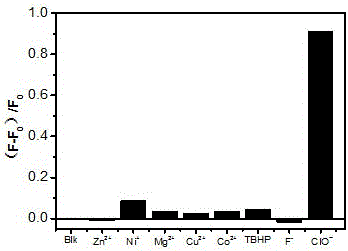Fluorescent probe having rapid hypochlorous acid detecting function and preparation method and application
A technology of fluorescent probes and hypochlorous acid, which is applied in the fields of life sciences, environmental sciences, and analytical chemistry, can solve the problems of high cost investment, complicated detection process, and restricted method application, and achieve low cost input, simple synthesis route, and post-production Easy to handle effects
- Summary
- Abstract
- Description
- Claims
- Application Information
AI Technical Summary
Problems solved by technology
Method used
Image
Examples
Embodiment 1
[0024] A preparation method of a fluorescent probe with hypochlorous acid detection function, comprising the following steps:
[0025] (1) Preparation of product 1.
[0026] Dissolve 4-bromo-1,8-naphthalene dianhydride (3mmol) and 4-(2-aminoethyl)morpholine (12mmol) in ethylene glycol methyl ether (100ml) and place on N 2 Under the conditions of protection and avoiding light, heat up to 90°C and stir and reflux for 6 hours. After the reaction is completed, filter, and then rotary evaporate to remove 85%~95% of ethylene glycol methyl ether, until the volume is about 5ml, then precipitate with water, and filter with suction to obtain The desired product was dried in vacuo to synthesize product 1.
[0027] (2) Product 2 was synthesized from product 1 and piperazine.
[0028] Dissolve the product 1 (0.3mmol) and piperazine (12mmol) synthesized in step (1) in dehydrated ethylene glycol methyl ether (10ml), and place the mixed solution in the dark and N 2Stir at room temperature ...
Embodiment 2
[0031] Embodiment 2: detection experiment of hypochlorous acid.
[0032] Take 12 5ml sample bottles, add respectively 3ml of the solution of the fluorescent probe configuration obtained in Example 1 (the concentration of the fluorescent probe is 10 μM, and it is prepared with an aqueous solution solution with a pH of 5 and an ethanol content of 13.6%), and then respectively Set the concentration to [ClO - ]=0(a), 1.0×10 -6 mol / l (b), 5.0×10 -6 mol / l (c), 2.0×10 -5 mol / l(d), 5×10 -5 mol / l(e), 8.0×10 -5 mol / l (f), 1.0×10 -4 mol / l (g), 1.5×10 -4 mol / l (h), 2.0×10 -4 mol / l(i), 2.5×10 -4 mol / l(j), 3.0×10 -4 mol / l (k), 3.5×10 -4 Add 3 μl hypochlorous acid solution of mol / l (l) into 12 sample vials, stir at room temperature for 20 seconds, and use 420nm as the excitation wavelength to measure the fluorescence intensity of these samples respectively, and obtain the fluorescence emission spectrum change diagram of the 12 samples, See image 3 . The measurement results show...
Embodiment 3
[0033] Example 3: Comparative detection experiment of other ions and the influence of peroxide.
[0034] Get 9 5ml sample bottles, respectively pack into 3ml of the fluorescent probe solution gained in Example 1 (the fluorescent probe concentration is 10 μ M, is to be the aqueous solution preparation of 13.6% ethanol content that is 5 with pH 5), then respectively The concentration is 1.0×10 - 4 mol / l Zn 2+ 、Ni 2+ , Mg 2+ 、Cu 2+ 、Co 2+ , TBHP (tert-butanol peroxide), F - , and ClO - Take 3 μl each and add to the other first 8 sample vials, and sample No. 9 is the blank sample. Then respectively measure the fluorescence emission intensity at 420nm wavelength excitation and 550nm wavelength emission of 9 samples, the results are shown in Figure 5 . The measurement results show that, except hypochlorous acid, other above-mentioned ions and peroxides have no obvious influence on the fluorescence intensity of the prepared fluorescent probe. (Note: The stirring time of H...
PUM
 Login to View More
Login to View More Abstract
Description
Claims
Application Information
 Login to View More
Login to View More - R&D
- Intellectual Property
- Life Sciences
- Materials
- Tech Scout
- Unparalleled Data Quality
- Higher Quality Content
- 60% Fewer Hallucinations
Browse by: Latest US Patents, China's latest patents, Technical Efficacy Thesaurus, Application Domain, Technology Topic, Popular Technical Reports.
© 2025 PatSnap. All rights reserved.Legal|Privacy policy|Modern Slavery Act Transparency Statement|Sitemap|About US| Contact US: help@patsnap.com



